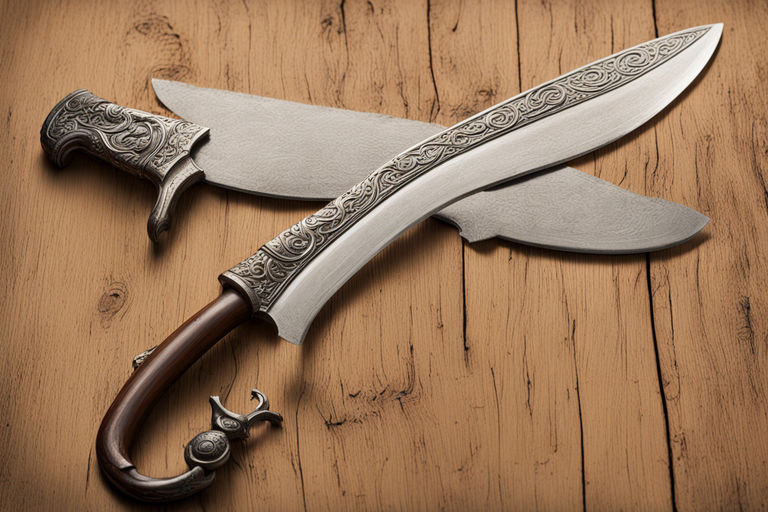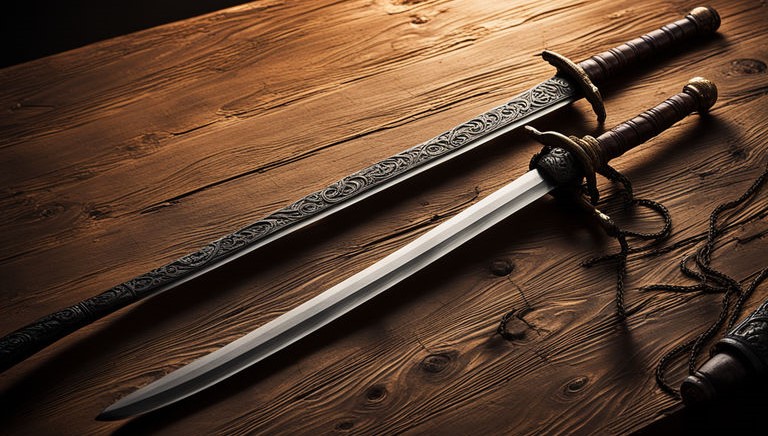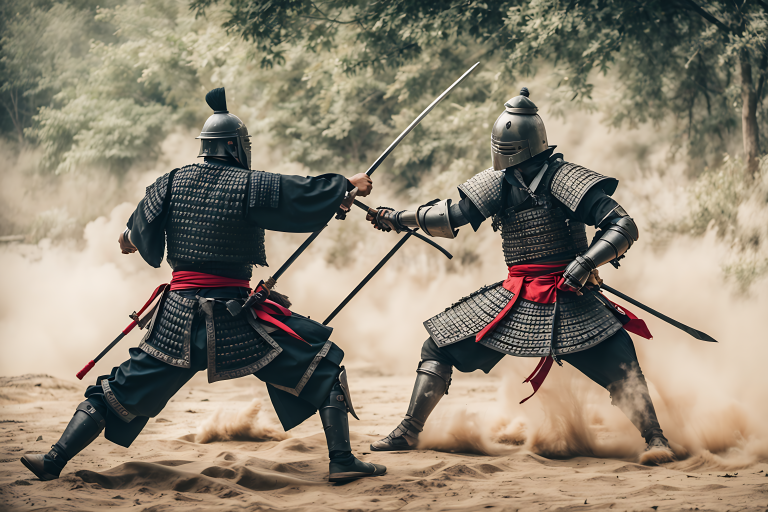Oveview
Are you familiar with samurai and their swords? This article will introduce you to the katana, a famous curved sword from Japan. While many people call any samurai sword a katana, there are actually different types! We’ll explore what makes the katana special and how it’s different from other samurai swords.

But here’s something a lot of people get mixed up: they think every sword a samurai used was a katana. Nope! While the katana is a samurai sword, not every samurai sword is a katana. There are lots of different types!
We’ll talk about the katana first. It’s special because of its curved shape and sharp edge. It’s great for quick, precise fighting up close. But there are other samurai swords too, like the tachi and wakizashi. They look different and are used for different situations in battles.
By learning about these differences, we can understand more about Japanese swords and clear up any confusion about katanas and other samurai swords. Come with us as we learn more about these awesome blades!
A katana is a really special sword from Japan. People all around the world think it’s super cool because of its shape and history. Let’s look at what makes a katana unique:
- Guard (Tsuba): This is like a shield near the blade to keep the hand safe during fights. Sometimes it’s decorated with cool designs.
- Handle (Tsuka): The part you hold onto. It’s wrapped in silk or leather to make sure you don’t drop it during a battle.
- Butt Cap (Kashira): This is at the end of the handle. It helps to balance the sword and also looks nice.
- Sheath (Saya): A cover for the blade, usually made of wood or a special shiny material.
- Blade Holder (Tang): This is what keeps the blade attached to the handle. There are different kinds, each with its own benefits.
Now, let’s talk about what makes the katana’s blade special:
- Curved Blade: The katana’s blade is bent a bit, which helps it cut better and move quickly in a fight.
- Cool Pattern (Hamon): One of the coolest things about a katana is the line you see along the edge. It’s made by heating and cooling the blade in a special way. This makes the edge super strong and sharp. It’s like a badge of honor for the person who made it.
Making a katana is a big deal in Japan. Skilled craftsmen, called “tosho,” spend a lot of time and care making each one. They use old techniques that have been passed down for generations. By folding and hitting different layers of strong steel, they create a blade that’s tough, flexible, and really sharp. It’s not just a sword, it’s a piece of Japan’s history and culture.
Samurai swords were like tools for different jobs, kind of like how you might have different types of pencils for drawing or writing. Let’s look at some examples:
Katana: This is the most famous one. It’s got a curved blade and can be used with one or two hands. Samurai used it a lot for fighting up close.
Tachi: This sword is like the katana but longer and more curved. Samurai would wear it hanging from their waist and use it mainly when riding horses.
Wakizashi: A shorter sword, usually worn with the katana. It was handy for tight spots or when inside buildings where a longer sword might get in the way.
Tanto: This one’s like a dagger with a straight blade. Samurai used it for lots of things, like self-defense or everyday tasks. Sometimes, they even used it in special ceremonies.
Each sword had its own job. The katana was for fighting and showed how skilled the samurai was. The tachi was for fighting on horseback. The wakizashi was like a backup sword for close fighting. And the tanto was handy for lots of things and also had its own important place in ceremonies. These swords were a big part of what made samurai who they were, showing off their fighting skills, how they lived, and their place in society.
Here are the main differences between a Katana and other types of Samurai Swords like the Tachi and Wakizashi:
- Length:
– Katana: It’s about 60 to 80 centimeters long, good for using with one or two hands.
– Tachi: Longer than the Katana, often over 80 centimeters, made for fighting while riding horses.
– Wakizashi: Shorter, around 30 to 60 centimeters, perfect for fighting up close or indoors.
- Curvature:
– Katana and Tachi: Both have curved blades, but the Tachi might have a deeper curve, especially for fighting on horseback.
– Wakizashi: Also curved, but not as much as the Katana or Tachi, good for precise moves in tight spaces.
- Wearing Style:
– Katana: Worn with the blade up, tucked into a sash at the waist for quick drawing.
– Tachi: Worn with the blade down, hanging from the waist or a shoulder strap, easy to reach while riding.
– Wakizashi: Usually worn with the Katana, both tucked into the sash, showing the samurai’s status and readiness for battle.
- Purpose:
– Katana:Used for both attacking and defending, strong for striking and blocking.
– Wakizashi: Smaller and easier to move, handy for fighting close up or as a backup if the Katana isn’t available.
– Tachi: Made for fighting on horseback, lets the samurai swing big while still controlling their horse.
These differences show how each sword was used for different jobs in samurai life and battle.
The katana is a special kind of samurai sword known for its length, curve, and how it’s good for both attacking and defending. But it’s not just a sword—it’s a big part of Japanese history and represents the honor and fighting skills of the samurai.
To learn even more about the katana and its importance, you can visit places like martial arts dojos or museums that focus on Japanese weapons and culture. There, you can really get into the world of the katana, where tradition and skill come together, and see why Japanese sword fighting is still fascinating today.

 Katana: This is the most famous one. It’s got a curved blade and can be used with one or two hands. Samurai used it a lot for fighting up close.
Katana: This is the most famous one. It’s got a curved blade and can be used with one or two hands. Samurai used it a lot for fighting up close. Tachi: This sword is like the katana but longer and more curved. Samurai would wear it hanging from their waist and use it mainly when riding horses.
Tachi: This sword is like the katana but longer and more curved. Samurai would wear it hanging from their waist and use it mainly when riding horses. Wakizashi: A shorter sword, usually worn with the katana. It was handy for tight spots or when inside buildings where a longer sword might get in the way.
Wakizashi: A shorter sword, usually worn with the katana. It was handy for tight spots or when inside buildings where a longer sword might get in the way. Tanto: This one’s like a dagger with a straight blade. Samurai used it for lots of things, like self-defense or everyday tasks. Sometimes, they even used it in special ceremonies.
Tanto: This one’s like a dagger with a straight blade. Samurai used it for lots of things, like self-defense or everyday tasks. Sometimes, they even used it in special ceremonies.


